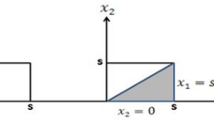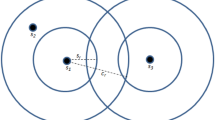Abstract
Lifetime is a major challenge in wireless sensor networks which depends on the energy consumption of the nodes. Energy limitation in nodes leads to many researches to find out new solutions for this problem. Clustering is an efficient solution for this issue. In clustering, all nodes that are distributed in an application zone should be partitioned into some virtual sections that are called clusters. Each cluster must have one node for managing intra-cluster tasks that is called cluster-head (CH). CHs are used for transmitting collected data to the base-station (BS). The multi-hop is one way of transferring CHs data to the BS which increases the data traffic on CHs near the BS. The unequal clustering is one of the solutions for solving bottleneck CH problems. The difference between equal and unequal clustering is in the type of cluster-radius, which could be fixed or variable. In this paper, a distributed unequal cluster-radius approach is proposed based on node density for clustering in WSNs that has two main phases: CH-selection and Member-join. CH-selection phase is based on global and local search, and member-join phase is done according to an evaluation function. Experimental results show that the proposed method leads to an increase in the lifetime of WSNs in comparison with state-of-the-art methods.







Similar content being viewed by others
References
Yetgin, H., Cheung, K. T., El-Hajjar, M., & Hanzo, L. H. (2017). A survey of network lifetime maximization techniques in wireless sensor networks. IEEE Communications Surveys & Tutorials, 19, 828–854.
Elhabyan, R. S., & Yagoub, M. C. E. (2015). Two-tier particle swarm optimization protocol for clustering and routing in wireless sensor network. Journal of Network and Computer Applications, 52, 116–128.
Amgoth, T., & Jana, P. K. (2014). Energy-aware routing algorithm for wireless sensor networks. Computers & Electrical Engineering, 41, 357–367.
Al-Junaid, A. F., & Al-kamali, F. S. (2016). Efficient wireless transmission scheme based on the recent DST-MC-CDMA. Wireless Networks, 22, 813–824.
Peng, S., Wang, T., & Low, C. P. (2015). Energy neutral clustering for energy harvesting wireless sensors networks. Ad Hoc Networks, 28, 1–16.
Saranya, V., Shankar, S., & Kanagachidambaresan, G. R. (2018). Energy efficient clustering scheme (EECS) for wireless sensor network with mobile sink. In Wireless Personal Communications (pp. 1–15).
Parvin, J. R., & Vasanthanayaki, C. (2015). Particle swarm optimization based clustering by preventing residual nodes in wireless sensor networks. Sensors Journal, IEEE, 15, 4264–4274.
Khan, I., Belqasmi, F., Glitho, R., Crespi, N., Morrow, M., & Polakos, P. (2016). Wireless sensor network virtualization: A survey. IEEE Communications Surveys & Tutorials, 18, 553–576.
Kuila, P., & Jana, P. K. (2014). Energy efficient clustering and routing algorithms for wireless sensor networks: Particle swarm optimization approach. Engineering Applications of Artificial Intelligence, 33, 127–140.
Gu, X., Yu, J., Yu, D., Wang, G., & Lv, Y. (2014). ECDC: An energy and coverage-aware distributed clustering protocol for wireless sensor networks. Computers & Electrical Engineering, 40, 384–398.
Chen, W., & Lea, C.-T. (2016). Oblivious routing in wireless mesh networks. Wireless Networks, 22, 2337–2353.
Tyagi, S., & Kumar, N. (2013). A systematic review on clustering and routing techniques based upon LEACH protocol for wireless sensor networks. Journal of Network and Computer Applications, 36, 623–645.
Tanwara, S., Kumarb, N., & Rodrigues, J. (2015). A systematic review on heterogeneous routing protocols for wireless sensor network. Journal of Network and Computer Applications, 53, 39–56.
Shin, H., Moh, S., Chung, I., & Kang, M. (2015). Equal-size clustering for irregularly deployed wireless sensor networks. Wireless Personal Communications, 82, 995–1012.
Baranidharan, B., & Santhi, B. (2016). DUCF: Distributed load balancing Unequal Clustering in wireless sensor networks using Fuzzy approach. Applied Soft Computing, 40, 495–506.
Azharuddin, M., Kuila, P., & Jana, P. K. (2015). Energy efficient fault tolerant clustering and routing algorithms for wireless sensor networks. Computers & Electrical Engineering, 41, 177–190.
Li, C., Ye, M., Chen, G., & Wu, J. (2005). An energy-efficient unequal clustering mechanism for wireless sensor networks. In IEEE International conference on mobile ad-hoc and sensor systems conference, (pp. 604–612).
Soro, S., & Heinzelman, W. (2005). Prolonging the lifetime of wireless sensor networks via unequal clustering. In Proceedings of the 5th IEEE International workshop on algorithms for wireless, mobile, ad hoc and sensor networks (pp. 236–243).
Chen, G., Li, C., Ye, M., & Wu, J. (2009). An unequal cluster-based routing protocol in wireless sensor networks. Wireless Networks, 15, 193–207.
Selvi, G. V., & Manoharan, R. (2013). A survey of energy efficient unequal clustering algorithms for wireless sensor networks. International Journal of Computer Applications, 79, 1–4.
Guiloufi, A. B. F., Nasri, N., & Kachouri, A. (2016). An energy-efficient unequal clustering algorithm using ‘Sierpinski triangle’ for WSNs”. Wireless Personal Communications, 88, 449–465.
Shokouhifar, Mohammad, & Jalali, Ali. (2017). Optimized sugeno fuzzy clustering algorithm for wireless sensor networks. Engineering Applications of Artificial Intelligence, 60, 16–25.
Logambigai, R., & Kannan, A. (2016). Fuzzy logic based unequal clustering for wireless sensor networks. Wireless Networks, 22, 945–957.
Lee, S., Choe, H., Park, B., Song, Y., & Kim, C. (2011). An energy-efficient unequal clustering algorithm using location information for wireless sensor networks. Wireless Personal Communications, 56, 715–731.
Arjunan, S., & Pothula, S. (2017). A survey on unequal clustering protocols in wireless sensor networks. Journal of King Saud University-Computer and Information Sciences. https://doi.org/10.1016/j.jksuci.2017.03.006.
Agrawal, D., & Pandey, S. (2018). “FUCA: Fuzzy-based unequal clustering algorithm to prolong the lifetime of wireless sensor networks. International Journal of Communication Systems. https://doi.org/10.1002/dac.3448.
Heinzelman, W., Chandrakasan, A., & Balakrishnan, H. (2000). “Energy-efficient communication protocol for wireless micro sensor networks. In Hawaii international conference on system sciences (HICSS) (pp. 10–19).
Younis, O., & Fahmy, S. (2004). HEED: A hybrid, energy-efficient, distributed clustering approach for ad hoc sensor networks. IEEE Transactions on Mobile Computing, 3, 366–379.
Bagci, H., & Yazici, A. (2013). An energy aware fuzzy approach to unequal clustering in wireless sensor networks. Applied Soft Computing, 13, 1741–1749.
Chang-jiang, J., Wei-ren, S., Min, X., Xian-lun, T. (2010). Energy-balanced unequal clustering protocol for wireless sensor networks. The journal of China universities of posts and telecommunications (pp. 94–99).
Logambigai, R., & Kannan, A. (2016). Fuzzy logic based unequal clustering for wireless sensor networks. Wireless Networks, 22(3), 945–957.
Baniata, M., & Jiman, H. (2017). Energy-efficient unequal chain length clustering for wireless sensor networks in smart cities. Wireless Communications and Mobile Computing. https://doi.org/10.1155/2017/5790161.
Corn, J., & Bruce, J. W. (2017). Clustering algorithm for improved network lifetime of mobile wireless sensor networks. In 2017 International Conference on Computing, Networking and Communications (ICNC). IEEE.
Baranidharan, B., & Balachandran, S. (2017). “FLECH: Fuzzy logic based energy efficient clustering hierarchy for nonuniform wireless sensor networks. Wireless Communications and Mobile Computing. https://doi.org/10.1155/2017/1214720.
Bhatia, A., & Hansdah, R. C. (2015). A distributed TDMA slot scheduling algorithm for spatially correlated contention in WSNs. Mobile Information Systems. https://doi.org/10.1155/2015/234143.
Gennert, M. A., & Yuille, A. L. (1998). Determining the optimal weights in multiple objective function optimization. In ICCV (pp. 87–89).
Heinzelman, W., Chandrakasan, A., & Balakrishnan, H. (2002). An application-specific protocol architecture for wireless micro sensor networks. IEEE Transactions on Wireless Communications, 1, 660–670.
Gong, D., Yang, Y., & Pan, Z. (2013). Energy-efficient clustering in lossy wireless sensor networks. Journal of Parallel and Distributed Computing, 73, 1323–1336.
Handy, M., Haase, M., & Timmermann, D. (2002). Low energy adaptive clustering hierarchy with deterministic cluster-head selection. In 4th international workshop on mobile and wireless communications network (pp. 368–372).
Albath, J., Thakur, M., & Madria, S. (2013). Energy constraint clustering algorithms for wireless sensor Networks. Ad Hoc Networks, 11, 2512–2525.
Author information
Authors and Affiliations
Corresponding author
Additional information
Publisher's Note
Springer Nature remains neutral with regard to jurisdictional claims in published maps and institutional affiliations.
Rights and permissions
About this article
Cite this article
Hamidzadeh, J., Ghomanjani, M.H. An Unequal Cluster-Radius Approach Based on Node Density in Clustering for Wireless Sensor Networks. Wireless Pers Commun 101, 1619–1637 (2018). https://doi.org/10.1007/s11277-018-5779-1
Published:
Issue Date:
DOI: https://doi.org/10.1007/s11277-018-5779-1




